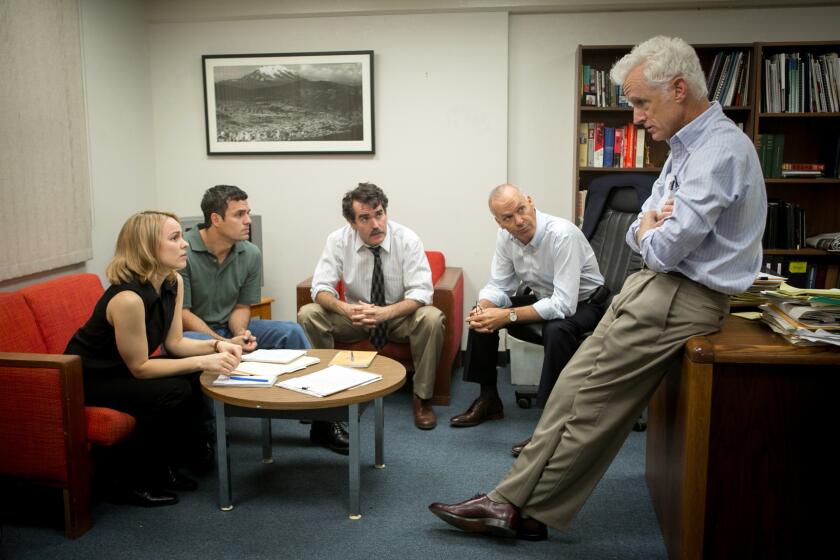Renae Williams Niles puts her personal stamp on dance in L.A.
Renae Williams Niles is a name that stirs little recognition, but she is the most powerful person in dance in Los Angeles.
It is her job, as director of programming, to select the companies and repertory for each season of Glorya Kaufman Presents Dance at the Music Center. But that description sells short her impact and influences in this city’s dance life.
Niles is highly regarded for her business acumen and knowledge of the art. Her unpretentiousness and sunny disposition have also won her fans. And she is an anomaly in the field: A rare female executive at a large multi-disciplinary performing arts facility who is young (38), African American, a former dancer (with the Lula Washington Dance Theatre) and a homegrown Angeleno (since age 13).
Niles is the first Music Center staff member specifically hired (in 2004) to direct a dance series. As such, she is writing a new chapter in the Music Center’s bumpy and convoluted history of presenting dance. The 10th anniversary season, which will be announced Monday, opens in September.
She has taken baby steps to expand the Music Center’s role to aid the local dance community. She chose the acrobatic-dance group Diavolo for a first-time Music Center residency and approved inaugural funding for the nascent L.A. Dance Project, led by”Black Swan”choreographer Benjamin Millepied.
While she must adhere to the Music Center’s “vision” for the series, Niles has enormous sway to put her own stamp on it — and she has.
She immediately began expanding the style of offerings, often seeking out contemporary companies with an ethnic-specific focus, such as Brooklyn-based Evidence. And she has taken risks with challenging choreography, such as the not-for-kindergartners’ “Snow White” byFrance’s avant-garde Ballet Preljocaj. The Bolshoi Ballet and other traditional troupes are still represented. But Niles has also given the Music Center’s prestigious platform to Corella Ballet (now Barcelona Ballet), a still-emerging company.
“There’s my personal love, but then that is somewhat different and broader, even, than the vision of the dance series,” said Niles, a USC graduate who majored in public relations. “The vision is very much focused on internationally renowned choreographic voices and… a focus on large-scale significant masterworks that more than likely wouldn’t have been presented to Los Angeles audiences [otherwise].”
While Niles and the series’ supporters extol its diversity, its artistic range and the inclusion of companies without marquee names have made it difficult to sell subscriptions. Subscribers total only 15% to 20% of the total audience, Niles said, adding that total paid attendance has varied between 70 and 85%, depending on the season.
Not every engagement has been an artistic or financial success, though single-ticket sales and $1.7 million in annual fundraising have kept the series on budget; a $20-million gift in 2009 from philanthropist Glorya Kaufman covers about 40% of that fundraising goal each year, said Stephen D. Rountree, the Music Center’s president and chief executive. Ballet Hispanico, for one, was in the midst of an artistic transition when it made a rocky debut at the Ahmanson in June 2009.
Niles is in charge of budgeting and marketing the series and she admitted that in retrospect, some of her selections should have been handled differently. But she is willing to take risks on dance companies that have “unique gifts.”
“There are certainly times when we definitely push it a little bit,” she said, sitting in an office decorated with dance posters, an oversize die signed by Merce Cunningham and other memorabilia. “But at the same time, as long as that company really does have that distinct choreographic voice … it makes sense to at least try it.”
The Music Center board approved the launch of the dance series before the Los Angeles Philharmonic made its jump from the Dorothy Chandler Pavilion into Walt Disney Concert Hall. Nonetheless, after the disastrous end to the Joffrey Ballet’s eight-year Music Center residency in 1991, and the grab-bag nature of past presentations, the directors were “concerned and anxious” that a quality series remain solvent, said Rountree, the Music Center president and CEO.
“We needed someone who was smart and savvy, but who was also a capable manager and producer, who knew the dance world,” said Rountree.
“Renae built it slowly, one step at a time… so that she built a comfort level and confidence with the board. They saw that she was a smart person who was not going to get us into trouble.”
Robert Battle, artistic director of Alvin Ailey American Dance Theater, said it is comforting to work with a director of programming who is so passionate and knowledgeable about dance. He and Niles ran into each other last January at the national presenters’ conference in Manhattan, and while they sat together watching a showcase, Niles talked with him about potential repertory for the company’s return to Los Angeles next season.
“The wonderful thing about her, in a way, is her youth. Also, I have to say that being an African American woman at such an important venue is significant,” Battle said. “But I also know that certainly from the business side, as sweet as she is, she can be tough when she needs to be.”
Niles has also developed a friendly relationship with Music Center donors and its most significant philanthropist, Kaufman, the widow of Donald B. Kaufman, co-founder of the home construction firm Kaufman & Broad. Kaufman donated $18 million to UCLA for the renovation of its historic dance building. For her gift to the Music Center, Kaufman gets a sneak preview of the series before it is announced publicly.
“I don’t love them all. That’s OK,” said Kaufman. “[But] honestly, I see a performance like ‘Snow White’ and it almost brings tears [of joy] to my eyes.”
She concluded: “I think Renae gets people to do what she wants with a smile on her face.”
Dance — and baton
The constants in Niles’ peripatetic childhood in Dayton, Tenn., and Los Angeles — after 15 residential moves, she stopped counting — were ballet, jazz, tap dance and competition baton twirling. (“Very Southern of me, right?!”) She didn’t want a career behind a desk, like her mother, who worked as a claims adjuster, paralegal and office manager while also playing piano in church. While Niles was studying at USC, she was given an increasing number of administrative duties by Erwin Washington, executive director of Lula Washington Dance Theatre, the 32-year-old repertory ensemble devoted to dance that tackles social issues and African American culture. It became clear that her star as an executive was rising faster than it would as a dancer. She became company manager when she graduated college.
“Renae learned everything I knew and then she learned a lot of things that I did not know,” Washington said. “She became much better at booking the company than I was. People would always say ‘yes’ to booking Lula if Renae was asking.”
Subsequent jobs, including marketing manager at downtown’s Grand Performances’ summer arts festival, turned into career stepping stones. Later, as director of grants at the County Arts Commission, she oversaw the distribution of $2.3 million in grants to 260 arts organizations.
Said the commission’s executive director, Laura Zucker: “From the very first day I interviewed Renae, my inner policy wonk saw a fellow policy wonk, someone who enjoyed thinking and implementing change in large systems and had the passion and knowledge to do it.”
Other experiences made equally significant imprints. At one job, Niles sat on a pile of phone books because there weren’t enough chairs; she is still a passionate advocate of basic-expenses funding, which carries less prestige in the philanthropic universe.
Her life-long commitment to diversity intensified when she and her family left the upper-middle-class African American neighborhood of View Park for two grittier, working-class neighborhoods, one near Pico-Union, the next at 37th Street and Normandie Avenue, where she lived during her freshman year at USC. Niles said the USC tram did not even go in the direction of those houses, though they were a mile away or closer from campus.
“Upstairs [in Pico-Union] were some USC grad students, and on either side were Mexican and Central American families. So that’s when I really learned ranchero music,” she said with a laugh. “Across the street is where they housed the ‘roach’ trucks — the food trucks of the ‘80s. It was, to say the least, a huge difference and dichotomy. It’s kind of made me who I am and the fact I feel comfortable almost anywhere.”
More to Read
The biggest entertainment stories
Get our big stories about Hollywood, film, television, music, arts, culture and more right in your inbox as soon as they publish.
You may occasionally receive promotional content from the Los Angeles Times.






